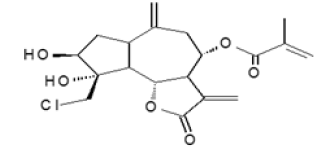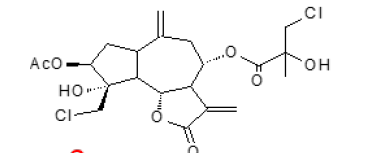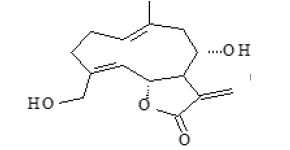Research Article 
 Creative Commons, CC-BY
Creative Commons, CC-BY
Biological Activity of Environmentally Friendly Plant Terpenoids
*Corresponding author:Zakirov Salakhutdin Khashimovich, Candidate of Chemical Sciences, Associate Professor of the department Biochemistry and Plant Physiology in Tashkent State Agrarian University, Shaykhantohur district, Tashkent, Uzbekistan.
Received: January 22, 2024; Published: January 31, 2024
DOI: 10.34297/AJBSR.2024.21.002838
Abstract
This article is devoted to the phytochemical study of sesquiterpene lactones of some plants of the Asteraceae family and their biological activity. At the same time, the effective growth activity of sesquiterpene lactones isolated by us from plants of the genus Artemisia was established, which improves the quality and increases the yield of rice, cotton and the productivity of mulberry cocoons. Also, a clear mutagenic, antinosema, antiviral and insecticidal activity of the number of lactones isolated from plants of the genus Centaurea and Acroptilon was revealed.
Keywords: Terpenoid; Sesquiterpene lactone; Asteraceae; Mutagen; Sericulture; Grena; Cotton; Rice; Termite; Extract
Introduction
Currently, the class of terpenoids, including sesquiterpene lactones, attracts the attention of a wide range of scientists working in the field of chemistry of natural compounds, not only for their various chemical and structural transformations, but mainly for their wide range of biological activity.
Sesquiterpene lactones, being a large group of secondary metabolites, have mainly mono-, di- and tricyclic carbon skeletons, as well as a lactone cycle [1,2].
They are widely distributed in flowering plants, especially the Asteraceae family, and in our republic these plants are an easily accessible raw material base for the wide production of medicines and pesticides. In order to create and introduce new highly effective medicines and pesticides, it is necessary to expand the development of methods for obtaining biologically active compounds from wild and medicinal plants. Among the sesquiterpene lactones we isolated from plants of the Asteraceae family, we identified compounds with insecticidal, growth-regulating, antitumor, antiulcer, antitermite, antifungal, antiparasitic, mutagenic activities and therefore scientific research in this direction is very relevant and promising.
Materials and Methods of Research
The object of the research is widespread plants of the genus Artemisia, Centaurea and Acroptilon, family Asteraceae.
Research Methods
phytochemical, technological, physicochemical, biological. Phytochemical and technological methods are used to develop the optimal technology for obtaining individual sesquiterpene lactones and the total lactones from plant materials (extraction of organic solvents, purification from ballast substances, separation by polarity and chromatographic separation. Physical and chemical methods - Infrared spectroscopy (IR), Ultraviolet spectroscopy (UFS), PMR- spectroscopy. Biological methods determine the bio stimulating, mutagenic, antiparasitic and insecticidal activity of the developed preparations.
Bio Stimulating Activity in Rice Growing
Sesquiterpene lactones, which have an α, β, -unsaturated exomethylene fragment in the γ-lactone cycle (heliangin, pyretrosine, allantolactone), are powerful inhibitors of plant cell growth. Sesquiterpenoids with a saturated lactone ring, on the contrary, have growth-stimulating activity. For example, pre-sowing treatment of rice seeds with sesquiterpene lactones showed that α-santonin, liganolide and repin stimulate seed germination and enhance the formation of the root system, which ultimately leads to an increase in rice yield by an average of 12.5%. The highest efficiency was shown by the sesquiterpenoid 2-keto-8a-hydroxy-5a,6b,7a,11b(H)-guai-1(10),3-dien-6,10-olide monohydrate(1). The growth-regulating properties of this sesquiterpenoid, which we called the drug “Risolid,” can effectively increase rice yield with a single pre-sowing treatment of rice seeds. Below are the results of biological studies of compound [1].
Based on the analyses, it can be seen that in the control variant, plant growth was 127cm, panicle length was 25.3cm, main panicle weight was 1.8g, side panicle weight was 0.8g, and the yield was 55.9centners per hectare. In variants 2-3 of field experiments (Risolid preparation 50 and 75g/t seeds), plant growth was 135-136cm, panicle length was 27.8-27.9cm, weight of the main panicle was 2.2cm, weight of the lateral panicle was 1 ,0-1.1g, the yield was 70.3-70.4centners, which was 14.4-14.5centners higher compared to the control (Table 1) [3-8].
Biostimulating activity in cotton growing: Ionizing radiation and chemical mutagens are mainly used in the selection of initial material in cotton growing. The use of mutagens of plant origin makes it possible to obtain valuable source material for breeding purposes in a short time. The preparation of plant origin "PRP", created on the basis of extractive substances of wormwood, showed biostimulating and mutagenic activity when tested on cotton. Cotton seeds of the C-6524 variety were soaked in a solution of the preparation of various concentrations and then they were sown in the field, which led to an increase in the number of fruit organs per bush and, accordingly, to an increase in the number and weight of bolls. Ultimately, the weight of raw cotton per plant increased [9-11].
Higher concentrations of PRP have been used in cotton seed irradiation as a modifier to relieve depression. The experiments were carried out on variety C-6524, which was soaked with 2 and 1% solution of PRP preparation and Co60 gamma rays. Seeds soaked in water, as well as simply irradiated, were used as control options.
As a result of the research, a number of mutant lines and varieties were obtained, which were studied in the nurseries of radiation mutagenesis. Two mutant lines are tested in competitive and station variety trials. Since the polar sum of wormwood showed biostimulating activity, to isolate the active principle, we studied the chemical composition of the aqueous extract of the aerial part of the raw material. A new water-soluble sesquiterpene lactone (I) was isolated with composition С 15Н22О5, M+ 282, m.p. 164-1650C (ethanol) [7-9].
Insecticidal Activity
The antifeedant activity of the sesquiterpene lactones elegin, acrotilin, hircanin and salegin was assessed in a test by eating mulberry leaves treated with lactone solutions by third-instar larvae of the silkworm Bombyx mori. It was found that the larvae stopped feeding on mulberry leaves treated with solutions of sesquiterpene lactones at a concentration of 0.1-1% (Figures 1-4).
Currently, two types of termites Anacanthotermes turkestanicus Jacobs and Anacanthotermes ahngerianus Jacobs are widespread in Uzbekistan, which cause enormous damage to buildings, structures and historical cultural monuments, and pose a particular danger and serious problem in the socio-economic life of the population. Although widespread control measures are underway to reduce termites, the damage they cause is increasing every year. A variety of effective insecticides used against termites generally have a temporary effect, as they have a short-term effect (no more than 3-5 days) and are also toxic. In this regard, there is an urgent need to develop low-toxic termite control agents using poisonous food baits of intestinal prolonged action that kill termites within 40-45 days.
In this regard, there is a need to develop environmentally friendly new methods and means of termite control. We have studied the termicidal activity of sesquiterpene lactones isolated from the plants Centaurea squarroza and Jurinea maxima. As a result of biological studies, it was established that a number of germacranolides have high intestinal termicidal activity with prolonged action.
For example, the sesquiterpene lactones knicine and salonitenolide lead to the death of termites by more than 90% [10-12] (Figures 5,6).
Fungicidal and Antiparasitic Activity
We have conducted studies to determine the antifungal activity of a number of sesquiterpene lactones (ayafin, ayafinine, fastafin, fastelin, chrysatermine B, isochrysatermine B, rupicolins A and B, hanfilin, canin) and various extracts containing the sum of sesquiterpene lactones, in against imperfect fungi that cause verticellosis and fusarium wilt, as well as black and common root rot. Chrysathermin B lactone at a concentration of 30mg/l has high activity against root rot, and against verticillium wilt caused by Verticillium dahlial, ayafinine lactone and petroleum ether extract from Ajania fastigiata.
The highest activity against black rot caused by Thielaviopsis bascola was demonstrated by chloroform extracts of Ajania fastigiata and Artemisia ashurbajevii in conc. 15mg/l. Globally, the production of live cocoons is growing, and at the same time, due to dangerous infectious diseases, 15-20% of the cocoon crop is damaged. We tested extracts (the sum of sesquiterpene lactones) isolated from various plants against silkworm nosematosis.
After treatment of grena with the sum of sesquiterpene lactones obtained from Artemisia tenuisecta (I), Artemisia annua (II), Acroptilon repens) (III) and Centaurea squarrosa (IV), determined the effect of the tested drugs on a much more important indicator of the quality of grena - its infection with nosematosis (that is, a decrease in infection). The results of infection of caterpillars after grena treatment in solutions of the sum of sesquiterpene lactones of various concentrations are presented in (Table 2).

Table 2: Infection of caterpillars with nosematosis after treatment with the amount of sesquiterpene lactones of different concentrations.
Presented on the (Table 2) data indicate that after the treatment of nosematosis grena with solutions of the sum of sesquiterpene lactones, the infection of hatched caterpillars with nosematosis decreased in all variants. Under a microscope, each caterpillar that emerged from the treated grena was individually examined. When treated with solutions of extracts, grenae infected with nosematosis led to a decrease in the infection of hatched caterpillars by 3.6-7.2% absolute, or by 44.4-88.9% relative, compared with the control. High protivonozematoses action showed funds with the code names IV at a concentration of 0.5%, I at a concentration of 1.0% and II at a concentration of 1.0%.
These total drugs have anthelmintic, antiprotozoal, antimalarial, anti-inflammatory and immunostimulatory activities. isolated from Artemisia tenuisecta (I), Artemisia annua (II) and Centaurea squarrosa (IV) plants. Located in gren, the causative agent of silkworm nosematosis belongs to the group of protozoan insect diseases. The active effect of the sum of sesquiterpene lactones on the causative agent of the protozoan disease of the silkworm can be established by the results of a decrease in the infection of caterpillars-animators with nosematosis. When grena is treated with the above preparations, the yield increases, which indicates the immunostimulating activity of the tested agents [13-15].
Conclusion
A phytochemical study of sesquiterpene lactones of some plants of the Asteraceae family, followed by a study of their biological activity, has established a pronounced growth activity of sesquiterpene lactones isolated by us from plants of the genus Artemisia, which improves the quality and increases the yield of rice by 12-14 c/ha and increases the productivity of mulberry cocoons. Based on the total lactones of Artemisia absinthium, which has mutagenic activity, two new varieties of cotton with economically valuable traits have been created. Created antinosema and antitermite agents based on the number of lactones isolated from plants Artemisia leucodes, A. annua, A. tenuisecta, Centaurea squarroza and Acroptilon repens showed high nosematosis of the silkworm, as well as brightly pronounced insecticidal activity, which destroys termites by 90-96%.
Thus, it has been established that plants of the Asteraceae family of the flora of Uzbekistan are promising rich sources of natural biologically active compounds and phytochemical research in this direction will lead to the rational use of local plant raw materials and the creation of environmentally friendly, highly effective plant pesticides.
References
- Seaman FC (1982) Sesquiterpene lactones as Taxonomic Characters in Asteraceae. Botanical review 48(2): 121-595.
- Merhatuly N (2015) Chemistry of mono- and bicyclic sesquiterpene γ-lactones. Karaganda pp. 165.
- Shevelukha RS (1992) Plant growth and its regulation in ontogenesis. Kolos pp. 210.
- Talwar KK, Singh IP, Kalsi PS (1992) A sesquiterpenoid with plant growth regulatory activity from Saussurea lappa. Phytochemistry 31(1): 336-338.
- Zakirov S Kh, Muxidova Z Sh, Kucherbayev K Dj (2014) Growth activity of terpenoids and their application in agriculture. “VESTNIK” of the South-Kazakhstan state pharmaceutical academy. Republican Scientific Journal 3(68): 78-79.
- Zakirov S Kh, Muxidova Z Sh, et al. (2022) Means for presowing treatment of rice seeds Patent for invention. No. IAP 07090.
- Abdurakhmanov AA, Biyashev GZ, et al. (1981) Wormwood is a source of natural mutagens. Izv AN Kaz SSR, biol 6: 4-8.
- Kovalchuk RI, Zakirov S Kh, et al. (1993) On the stimulating and mutagenic effect of extractive substances of wormwood on cotton. Uzbek biol Journal 6: 59-62.
- Kh.Zakirov, ID Shamyanov, Z Sh Mukhidova, ND Abdullaev (2019) XIII Interational Symposium on the Chemistry of Natural Compounds. Shanghai2019. New watersoluble sesquiterpene lactone from Artemisia absinthium L p. 251.
- C Guillet, J Harmentha, TG Waddell (2000) Synergetic Insecticidal Mode of Action between Sesquiterpene Lactones and Phototoxin, α- Tertienyl. Photochem and Photobiol 71(2): 111-115.
- Zakirov S Kh, Muxidova Z Sh (2019) Natural ecologically safe antithermite agents. Journal of Science and Innovative Development Tashkent (1): 73-77.
- Zakirov S Kh (2018) Antitermite agent and method of obtaining it. Patent for an invention. No IAP 05623
- Adekenov SM, Kulyyasov AT, Berdin AG, et al. (1999) Antiviral activity of sesquiterpene lactones Tez. International Conference "HIV, AIDS and related problems" St. Petersburg 3: 54.
- Kashkarova LF, Shamyanov ID, Ziyaeva Ya M, Mukhamatkhanova RF (2004) On the effect of sesquiterpene lactones on increasing the resistance of the silkworm to spontaneous nuclear polyhedrosis. Uzbek Biol Journal 6: 12-16.
- Nurmurodova NF, Ismatullaeva DA, Mukhidova Z Sh, Zakirov S Kh (2020) Effectiveness of Natural Terpenoids in the Prevention of Nosematosis of Here. Solid State Technology Blind Peer Review Referred Journal 63: 276-282.










 We use cookies to ensure you get the best experience on our website.
We use cookies to ensure you get the best experience on our website.